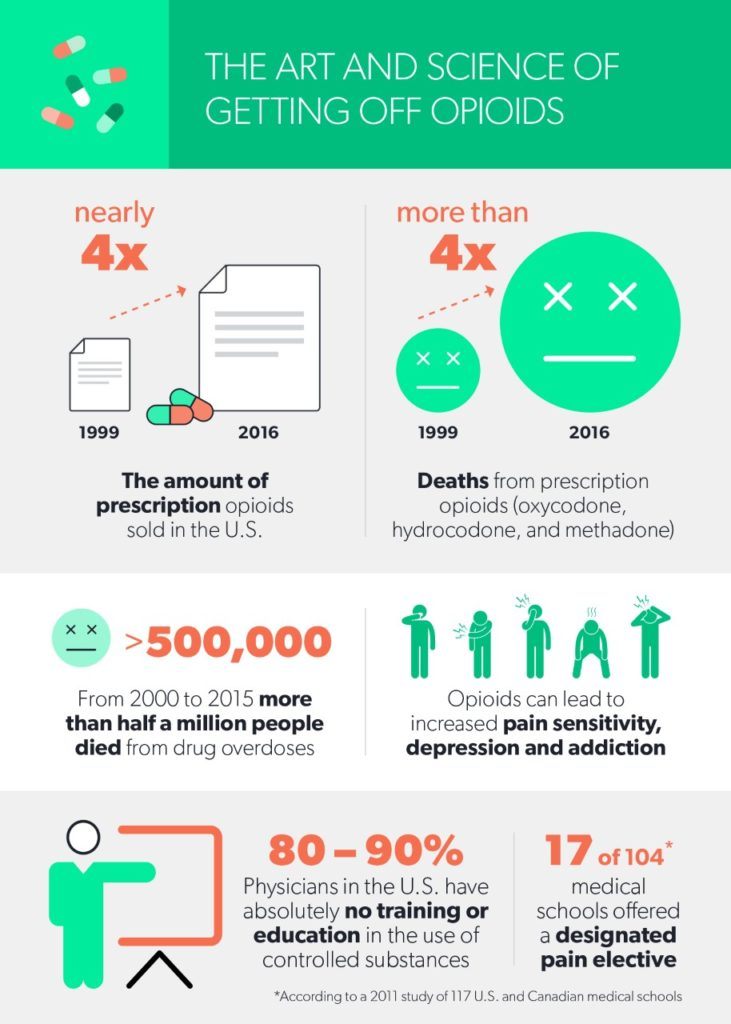Every day, 91 Americans die from opioid overdoses according to the Centers for Disease Control and Prevention (CDC). Overdoses from prescription opioids started to increase in the mid-90s, and since 1999, the amount of prescription opioids sold in the U.S. has nearly quadrupled. Increased prescription of opioids was thus a significant factor associated with the increase in opioid overdose deaths between 2000 and 2015, according to the CDC.
While there is now widespread awareness about the opioid crisis, opioids continue to be prescribed for injured workers. However, the development of opioid use guidelines by various entities, including the CDC, has spurred many physicians to abruptly cut back on either the quantity or the dose of opioids prescribed in order to be in compliance with guidelines. This has alarmed those injured workers already taking opioids who are concerned about how they will manage their pain with lower doses or without opioids entirely.
Most injured workers using opioids are not aware that the drugs themselves can lead to increased pain sensitivity as well as other serious side effects such as depression and addiction. Informing injured workers who are prescribed opioids after an injury or a surgery about the risks and benefits in addition to developing a plan, right from the start, for tapering off the opioids would facilitate the weaning process. But most physicians who prescribe the drugs are not familiar with how to wean injured workers off them, especially injured workers who have been on opioids for many years. The focus of this article is on tapering injured workers already taking opioids either to lower doses or completely off of the drugs.
There is a plethora of guidance for prescribers regarding the initiation and maintenance of pain management therapy. However, there is very limited actionable guidance on tapering therapy when the drugs are no longer effective, no longer appropriate or the risks outweigh the benefits — especially the “when” and the “how” of tapering. A 2014 report by the Public Broadcasting Service Newshour stated, “In fact, 80 to 90 percent of physicians in the United States have absolutely no training or education in the use of controlled substances.” A 2011 study of 117 U.S. and Canadian medical schools found that only 17 of 104 medical schools offered a designated pain elective.
Regardless of their lack of education in pain management during their training years, the question to be answered now is do providers have enough evidence-based directed guidance available to help them effectively taper injured workers off drug therapy in chronic pain cases? There are now many opioid treatment guidelines available but not as much information on how to manage the weaning process or on what to offer, other than opioids, to treat the injured worker’s pain.

For tapering to be successful, the provider needs to develop an individualized plan for the injured worker that is based on the best evidence-based weaning recommendations. The limited availability of clinical standards for tapering drug therapy compounds the problem of the under-education of prescribers regarding management of chronic pain. Prescribing a drug regimen is relatively easy, but reducing or removing a drug regimen is significantly difficult. However, there are some guidelines available, including those from the CDC.
Drug tapering, the gradual reduction in dosage over several months or longer, is a medically safe strategy to reduce long-term dependence on opioids. Abrupt denial of payment for opioid treatment can lead to medically dangerous withdrawal symptoms and drug-seeking behavior and is not recommended (although if urine testing indicates that an injured worker may be engaging in illegal activities such as drug diversion, denial of payment without tapering may be appropriate). In most cases, however, discontinuation of payment for opioid therapy should be made in collaboration with and in support of a physician-supervised tapering plan.
Caution and good judgment are required in developing a tapering plan. The CDC confirms that “there is a tendency among many well-meaning clinicians to prematurely taper injured workers off maintenance medications.” The CDC guidelines state, “Experts noted that injured workers tapering opioids after taking them for years might require very slow opioid tapers as well as pauses in the taper to allow gradual accommodation to lower opioid dosages.” By very slow, the guidelines mean it could take weeks or even months.
The tapering plan might include use of maintenance medications to alleviate withdrawal symptoms; these will also need to be tapered off once the injured worker is no longer at risk for acute withdrawal symptoms. Alternative treatments for the injured worker’s pain also should be strongly recommended and, if possible, initiated during the weaning process. These include physical therapy, cognitive-behavioral therapy, over-the-counter analgesic medications, and psychotherapy. Counseling regarding the psychology of pain is enormously helpful for injured workers who are having difficulty living with their pain. Patients should also be advised that even with the most gradual tapering plan possible, they may still experience mild withdrawal symptoms and/or pain for quite some time.
The most important message to convey to injured workers undergoing a tapering plan is that they must stick with the plan even if there is some degree of pain or withdrawal present. Patients may be fearful of making changes to their medications, but many will notice that they were experiencing higher sensitivity to pain when they were on opioids. Patients will need a lot of support and encouragement throughout this process. Physicians who are not able to offer the necessary degree of support and counseling should consider referring their injured workers to a pain management program that has the following:
- Experience with the tapering process.
- • A proven track record of not using added opioids to treat flare-ups during the weaning process.
- Ability to offer pain coaching or pain psychology services.
- No pressure placed on recovering workers to have invasive procedures or operations.
- A good weaning success rate among their injured workers.
Finally, predictive analytics can be used to identify injured workers who are at risk for opioid issues. The earlier and more accurately these injured workers can be identified, the sooner an intervention can occur to ensure that they are not going to be at risk for opioid addiction.
 Dr. Laura B. Gardner is a physician entrepreneur who founded and ran Axiomedics Research, Inc., a successful consulting company for 22 years before joining CLARA analytics as VP of Products. Her primary focus is providing claims teams and network managers with predictive analytics-based software tools that help to improve outcomes for injured workers. Visit www.claraanalytics.com/ and follow CLARA analytics on LinkedIn, Facebook and Twitter.
Dr. Laura B. Gardner is a physician entrepreneur who founded and ran Axiomedics Research, Inc., a successful consulting company for 22 years before joining CLARA analytics as VP of Products. Her primary focus is providing claims teams and network managers with predictive analytics-based software tools that help to improve outcomes for injured workers. Visit www.claraanalytics.com/ and follow CLARA analytics on LinkedIn, Facebook and Twitter.
Was this article valuable?
Here are more articles you may enjoy.


 Billionaire NFL Owner Suing Over Billboards Near His SoFi Stadium
Billionaire NFL Owner Suing Over Billboards Near His SoFi Stadium  The Return Period for An LA Wildfire-Scale Event May Be Shorter Than You Think
The Return Period for An LA Wildfire-Scale Event May Be Shorter Than You Think  Musk’s xAI Faces California AG Probe Over Grok Sexual Images
Musk’s xAI Faces California AG Probe Over Grok Sexual Images  NYC Sues Delivery App Over Lost Pay in New Mamdani Crackdown
NYC Sues Delivery App Over Lost Pay in New Mamdani Crackdown 